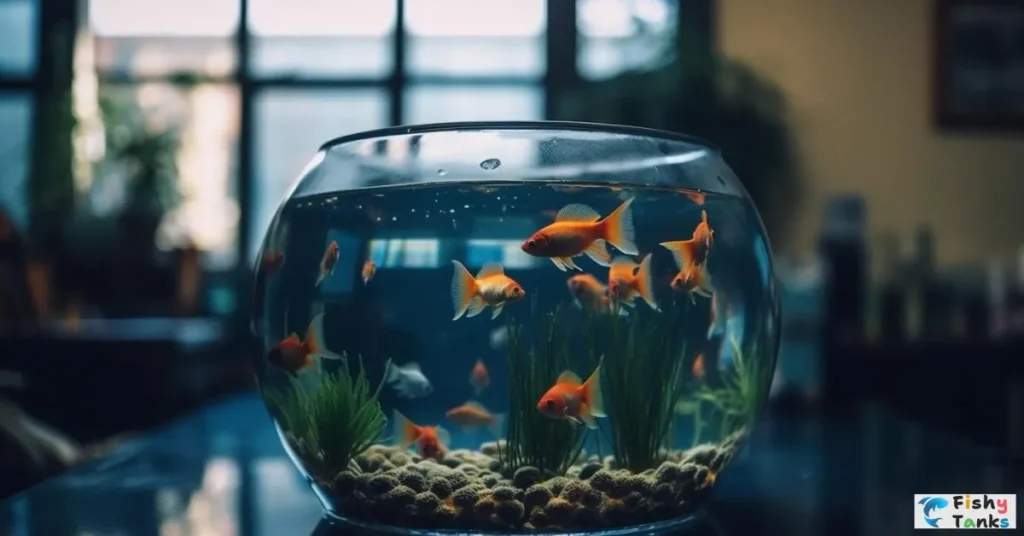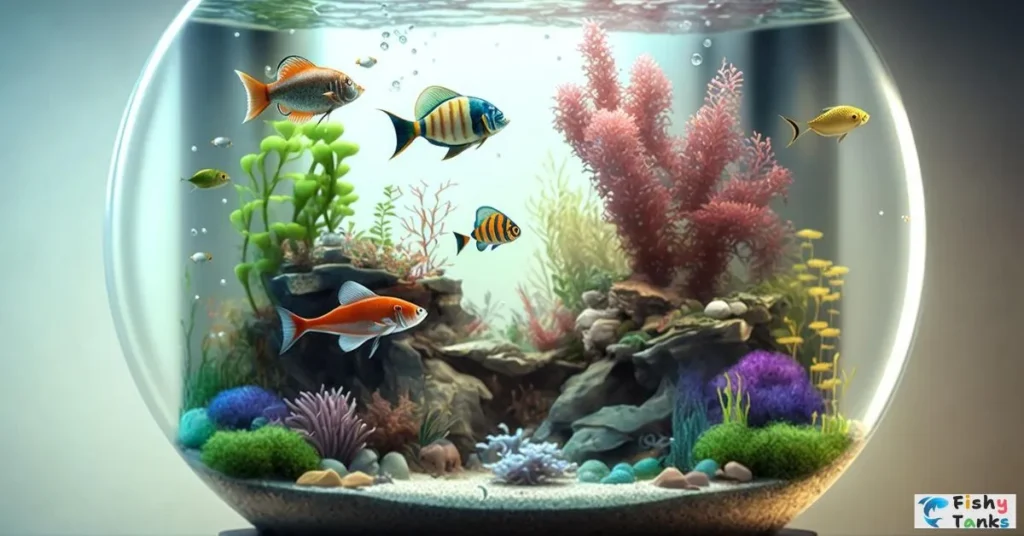Introduction
Cleaning their colony is important for all fish, but common cleaning methods obtain that by taking out the fish first which is stressful and harmful. In this guide, we’ll explore a gentle approach to aquarium maintenance fishkeeping is tricky as can be understood in this case of removing contaminants and algae growing without displacing the fish. We should start by considering making their comfort and health our most important goal which, in turn, will result in a pristine environment. To clean a fish tank without removing the fish, Come and get involved as we elucidate some of the helpful tips and strategies for keeping your aquarium clean and harmonious with the fish when you do not need to disturb them.

How to Clean a Fish Tank Without Removing The Fish
Understanding the Importance of Regular Tank Maintenance
Clean water is not only crucial for the health of fish but also for the general welfare of the entire aquatic ecosystem. In people, air provides the breath they need, whereas for fish it gives the life they live. In cases when the life-support system malfunctions, the aquarium can become contaminated by ammonia, nitrites, and nitrates, which create algae and deteriorate water quality for the fish. Different such become exposed and are up to disease and health problems within marine ecosystems.
The routine tank upkeep averts possible pollution, removing the left foods, uneaten food, and waste, through which people add their unwanted substances to the natural water sources. To clean a fish tank without removing the fish, One of the main practical implications of proper fishkeeping is that periodic water changes and cleaning of the tank accessories can minimize the chances of diseases being transmitted and allow for a more stable environment for the fish pets.

How to Clean a Fish Tank Without Removing The Fish
Tools and Supplies Needed for Cleaning the Fish Tank
Aquarium Gravel Vacuum
Not only for removing wastes but also apparatus for holding fish without pulling out stones.
Algae Scrubber or Scraper
Intended the removal of the algae from the glass panels of the aquarium to keep the visibility to a maximum as well as the aesthetics.
Bucket
To keep the aquarium supply tank clean, collecting and disposing of used water during water change requires a clean bucket.
Aquarium Water Conditioner
Aids the dechlorination of dangerous chemicals such as chlorine and chloramines in tap water by making it safe to use for fish.
Fish Net
Used for the cleaning or maintenance of fish compartments, the process may require the movement of fish occasionally.
Clean Cloth or Sponge
Offers you this capability: wipe around the tank periphery and process the equipment to get rid of dirt and algae easily.
Water Testing Kit
Indispensable for measuring water parameters such as pH, ammonia, nitrite, and nitrate concentration to herald the best water quality.
Filter Media
Change or clean cartridge filters when required and keep the equipment running well. The water in the tank should remain clear.
Bucket or Jug for New Water
Used for preparing the wonderful treated water to meet the water change requirements.
Gravel or Substrate Cleaner
Stir up and bring up dirt particles from the substrate into the water column so that they can be removed during water changes.
Algae Magnet
The algae are always messing up the tank glass, and I have to clean them up without getting my hands wet.
Gloves
It can also be optional but of great value to keep your hands secure during the process of cleaning from any chemicals or rough surfaces.
Preparing For Cleaning the Fish Tank
Before you start cleaning gather all the necessary stuff like gravel vacuum, algae scraper, bucket, water conditioner, fish net, clean cloth or sponge, water testing kit, filter media, bucket or jug for new water, gravel or substrate cleaner, algae magnet, and disposable gloves. Please check that you have gathered everything and that you are secure before shutting off electricity to heaters, filters, and lights in the aquarium so that both you and the fish are not hurt.

How to Clean a Fish Tank Without Removing The Fish
Shut off any corded power sources and move them away from water to eliminate the possibility of accidents. To clean a fish tank without removing the fish, If necessary, put a separate glass with some water from the tank on hand to hold the fish while cleaning is carried out. Apply a fish net to untangle the amphipods and move them to the container, making sure it has sufficient water flow and a lid. Find out the volume of water to be changed based on the tank size and current water conditions, and have enough treated water pre-prepared so that the process of water change matches with that of tank water.
Place a few towels or a mat near the aquarium to catch any spills and thus avoid damaging the surfaces around the aquarium with water. Make sure all pieces of the aquarium apparatus function properly and meet no damage. Replace or clean filter media if necessary. Meanwhile, make a set of cleaning procedures, which should be based on task prioritization, including the gravel vacuuming, glass washing, and water change, with enough time allocated for each step to ensure that every step is done properly.

How to Clean a Fish Tank Without Removing The Fish
Cleaning the Tank Without Removing Fish
Prepare Equipment
Gather together the cleaning tools in addition to supplies including a gravel vacuum, algae scraper, clean cloth or sponge, water conditioner, and a bucket or jug that you need to fill with new water.
Turn Off Equipment
Before any handling, please make sure that all electrical equipment connected to the aquarium is turned off as a precaution such as heaters, filters, and lights, to avoid accidents during the cleaning process. Unplug the power cords and position them in a dry place away from water.
Partial Water Change
Pull out a quantity of water from the tank, for instance, 20-30%, using a gravel vacuum. Do this without either the fish or tiny particles being affected. Discard the used water into a bucket or drain.
Clean Glass and Decorations
You can use an algae scraper or a clean cloth to take off the algae sticking on the glass walls. Carefully clean the surface of decorations and ornaments to remove any dirt and algae built up.
Vacuum Gravel
A gravel vacuum is an enabling tool that allows for the cleaning of the substrate. To clean the substrate stir the gravel gently to release debris and waste, then siphon out the dirty water. Take care where you step, particularly around the edge of plants, and do your best to preserve the substrate by not digging too deeply.

How to Clean a Fish Tank Without Removing The Fish
Refill Tank
Prepare refined water from a second tank independently to match the corresponding temperature and parameters with that of the tank water. By pouring the water slowly but ever so gently into the tank, lift any fish or disturb any substrate.
Add Water Conditioner
Use the water conditioner to alter the tap water so that it is suitable for the fish, removing any harmful chemicals that might be present. Take the product according to the instructions provided on the label.
Restart Equipment
After the tank has been filled with clean water reconnect all the electrical appliances and turn on filters, heaters, and lights. Monitor the temperature and water parameters to maintain the healthiest environment for babies.
Observe Fish Behavior
Keep a close watch on the fish after doing cleaning activity to make sure that they do not seem stressed or disturbed. They make sure they are swimming normally and eating like they used to, that is, in the most natural environment they could be in.
Dealing with Algae Problems
Algal growth cases must be examined to determine and eliminate the reasons they happen. Feeding at higher amounts and the lack of water changes create the condition whereby extra nutrients emerge, causing the development of algae. Regulate feeding and remove the water continuously to keep water of high quality. Reduce the extension of the lights or reduce their intensity and ensure a good water supply for the inhabitants to have good circulation. Also, eliminate the stagnant areas. Routine maintenance that entails the physical isolation of algae is necessary because it will control its spread. To clean a fish tank without removing the fish, Alternatively, algae-eating organisms that can be introduced include certain fish species and invertebrates. Regularity and the trait of patience are key; although algae may not be eliminated right away, cleanliness can be achieved with a simple approach. It will just require monitoring and maintaining the algae-free aquarium environment.
Handling Waste and Excess Debris
Regular maintenance is an important point that takes care of the waste and other unwanted things in the aquarium. Unsustainable feeding and out-of-order cleaning create a condition of the buildup of unfinished food, fish waste, and disintegrating natural matter which decreases the quality of water. To clean a fish tank without removing the fish, create a feeding schedule to just let what the fish can eat in a few minutes only, removing any uneaten food immediately after. Use a gravel vacuum during water changes to create an active water circulation that siphons the debris out from the substrate, preventing it from decomposing and opening it to toxic substances in the water. Furthermore, replace the filter media as frequently as possible to attain maximum filtration rate and remove excess wastes. Maintaining a maintenance schedule can completely thwart waste accumulation from happening and offer a disease-free and healthy home to your fish.
Conclusion
keeping the aquarium in good condition is of the essence when considering the health of the fish. One of the strategies to achieve this is through routine maintenance operations like partial water changes, algae control, and the processing of waste substances, which all work together to create a fertile environment leading to better fish conditions. To clean a fish tank without removing the fish, Moreover, during cleaning concentrations, eliminating fish removal whenever necessary supports fish comfort and succeeds in maintaining an aquarium ecosystem in equilibrium. Write down the water parameters control and confront any detected problems in time to prevent infectious diseases from uprising and to maintain optimal water quality. Through commitment and careful attention to the tanks and the fish in them, you can have a beautiful aquarium that will stand the passage of time and be a home for fish that are happy and healthy for years to come.
FAQ’s
1. How much should I clean my fish tank?
Although doing partial water changes and tank surface cleaning every 1-2 weeks is advisable, taking care of water quality and removing debris, is a necessary step.
2. What’s the best way to get rid of algae in my aquarium?
The water tank has to be maintained frequently. This can be achieved by controlling light exposure, introducing organisms whose role is to eat algae, and siphoning out dead algae by the water changes.
3. Can I clean my fish tank without removing the fish?
Yes, you can carry out some parts of the fish tank cleaning process without removing the fish such as using delicate procedures including vacuuming the gravel, removing algae, and partial water change.
4. How do I prevent cloudy water in my fish tank?
Frequently, turbid water such as that caused by bacterial blooms or due to excess organic matter is responsible. Routine water changes, an appropriate filtration system, and avoiding overfeeding will allow you to prevent cloudy water and keep the water clear in the long run.
Also Must Read: What Type of Filter is Best For a Fish Tank